Marchmont Road Flood Alleviation Scheme (2024)
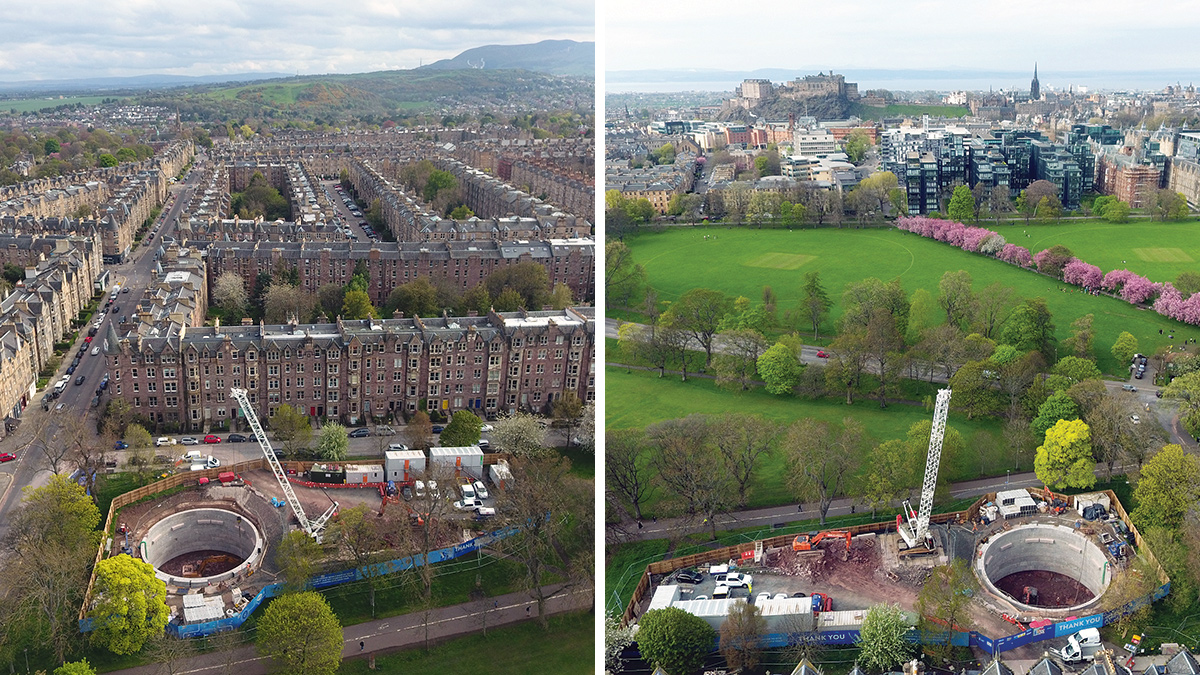
Marchmont Road FAS stormwater storage tank under construction - Courtesy of Paul Milligan & Caledonia Water Alliance
Marchmont is a residential area of Scotland’s capital city, Edinburgh. The area is characterised by four and five storey sandstone tenements blocks built in the Scots Baronial style. Most of the area was developed in the 1870s and 1880s and there has been little change to its structure since then. It is a mile from Edinburgh’s Old Town and is located right by the popular Meadows and Bruntsfield Links. The area remains popular with older residents, young professionals and students due to the short distance to the University, the city centre and the abundance of parks on their doorstep. For several years, persistent flooding has been impacting businesses and residents in the area of Edinburgh due to a lack of capacity in the existing sewer network and an increase in frequency and intensity of heavy rainfall events.
Introduction
Scottish Water is investing £8.9m to increase the sewer network capacity and storage within the Marchmont catchment which will reduce the risk of flooding to businesses and residents who have been affected by flooding.
Starting on site in August 2022, Marchmont Road Flood Alleviation Project is being delivered by Scottish Water’s alliance partner Caledonia Water Alliance, with completion scheduled for December 2024.
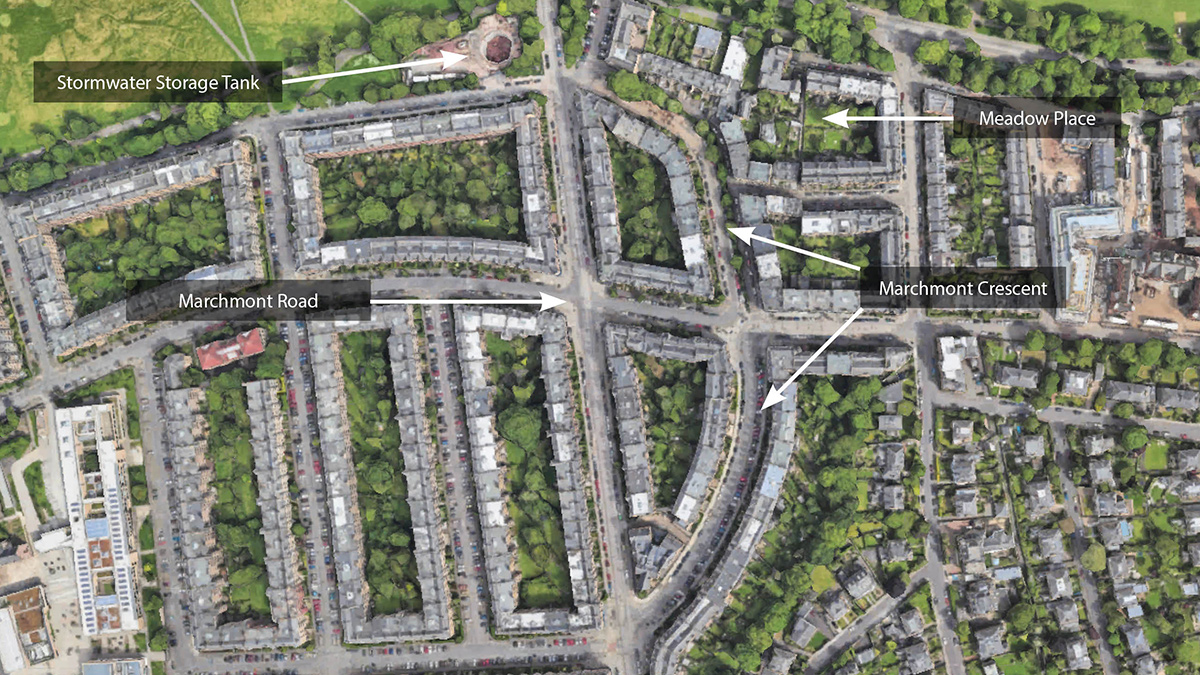
Google Maps image showing location of the site
The solution involves the installation of 700m of new and upsized sewer along Marchmont Crescent off Marchmont Road, which connects back to the existing network at Meadow Place. Storm flows will then spill via a new bifurcation chamber on Marchmont Road into a new 20m diameter, 3,000m3 volume offline storm storage tank located within Bruntsfield Links.
Sewer levels will be monitored in the downstream network and following a heavy rainfall event, storm flows will be pumped back into the network.
Project scope
- Construct a 20m internal diameter, 17m deep attenuation tank using underpinning methods to provide 3000m3 of storage and housing a internal tank cleaning system Vacflush™ column from CSO Group Ltd.
- Install two pumps (duty/standby) with two DN250 DI rising mains with pumped return to the existing combined sewer network.
- Install approximately 700m of new, upsized sewer ranging from DN250-DN900, with a range of materials: ductile iron, concrete, polyethylene and GRP.
- Install 24 PCC manhole to a depth of 4.5m.
- Retain the existing mature trees around Bruntsfield Links and Marchmont Crescent, by using two trenchless construction methods:
- Guided auger bore on Marchmont Crescent with a steel sleeve 762mm OD with a GRP slip lines within 672mm internal diameter. The works had to be undertaken below mature tree roots.
- Timber Heading in two directions within Marchmont Road into Meadows Park and out into Meadows Place to avoid RPAs and to maintain traffic flow on a major bus and emergency services route.
- Install a bespoke PCC bifurcation chamber/break discharge chamber.
- Install two kiosks: (i) MCC kiosk for pump operation, and (ii Vacflush™ kiosk for tank cleaning system.
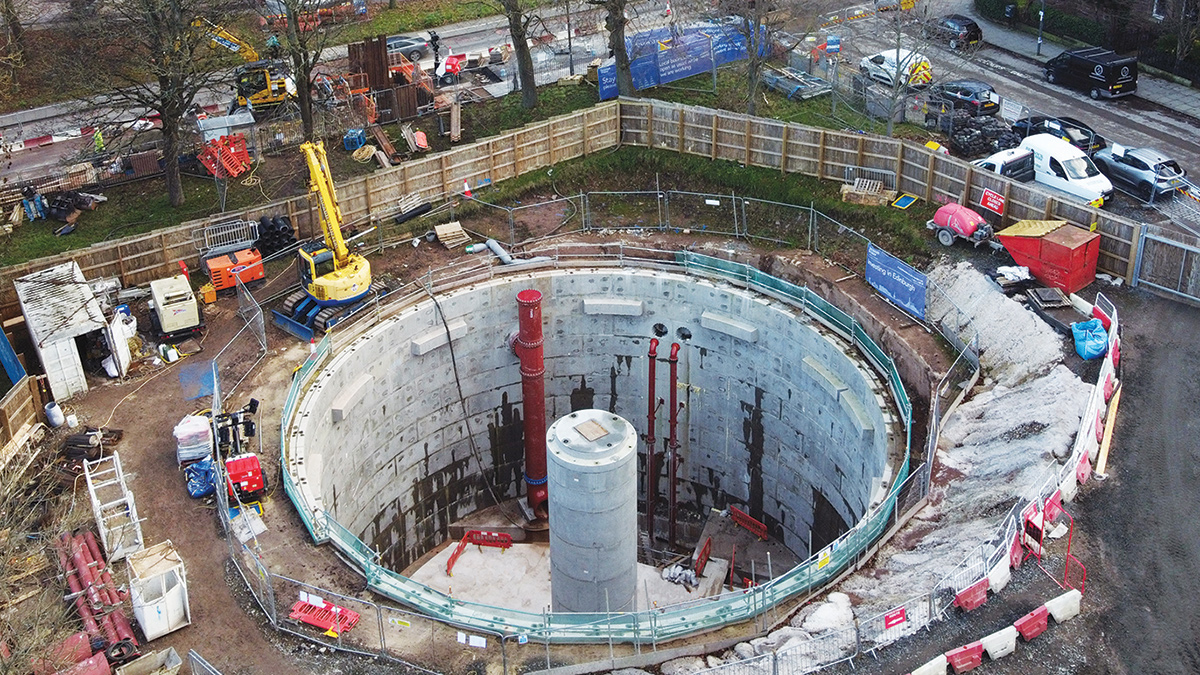
Storm tank under construction – Courtesy of Paul Milligan & CWA
Marchmont Road FAS: Supply chain – key participants
- Project delivery: Caledonia Water Alliance (CWA)
- Designers: AECOM/CWA
- Shaft & timber heading trenchless work: Fineturret Ltd
- MEICA installation & commissioning: Ferrier Pumps Ltd
- Pipe drive/pipe jack: Pipeline Drillers Ltd
- VacFlush™: CSO Group Ltd
- Composite steel reinforced pipe: Aquaspira Ltd
- Storm tank pumps: Xylem Water Solutions
- Access covers: EJ Group
- Precast supplier: Macrete (Ireland) Ltd
- Temporary ground support: Groundforce
- Over pumping: Selwood
Construction issues and carbon, cost & programme savings
Excavation within rock: Bedrock was encountered throughout the site approximately 1m below ground level. This resulted in slow digging periods for pipelaying within Marchmont Road and lengthy road closures.
Deep excavations in public space: The installation of the below-ground attenuation tank required excavations down to 17m within public green space. This has required extensive excavation support.
Trenchless construction: At both areas of trenchless construction, CWA deployed methods which preserved the mature trees in the area as required by City of Edinburgh Council ensuring compliance with the approved planning conditions and avoiding reputational damage to CWA and Scottish Water.

Marchmont FAS project site – Courtesy of Paul Milligan & CWA
Changes to the pipe specification within the augerbore: For the trenchless construction elements, for both safety of personnel and carbon reductions, the design was changed for DN900 ductile iron pipework to DN900 Aquaspira; a composite steel reinforced pipe. The Aquaspira pipework installed was over 7.5 times lighter per metre than the equivalent ductiile iron pipework. This allowed for the pipework to be pulled by hand along the track.
GPR pipeline installation within augerbore: There were significant carbon savings with the installation of GPR pipe, which is 10% of the weight of the equivalent diameter concrete pipework.
Removal of valve chamber: As agreed with Scottish Water during the detailed design stage, CWA designed a 5.5m wide x 5m long x 5.1m deep PCC valve chamber. The reason for this removal was that the relevant fittings and valves could be accommodated within the attenuation tank and downstream flow meter chamber. This was met with the acceptance and praise from Scottish Water as it reduced the excavation within Meadows Park, meaning a greater chance of planning approval, and a result, in carbon savings. The removal of the valve chamber for flood alleviation schemes with large diameter storage tank installation, is being promoted as a new standard for future designs.
Storm tank construction
The new storm tank will hold up to 3.5 million tonnes of stormwater, which will be directed to the tank via the new pipework. The tank fills up during a storm, and the water is pumped back into the sewer network once the storm subsides. This allows further capacity for future storm events.
The new storm tank was constructed under the Bruntsfield Links to reduce the risk of internal and external sewer flooding in the Marchmont area. CWA hit a huge milestone in March 2024, when the roof of the storm tank was lowered into place. The roof is made up from reinforced concrete beams and slabs, and weighs over 400 tonnes, covering the 15 metre wide by 20 metre deep tank.
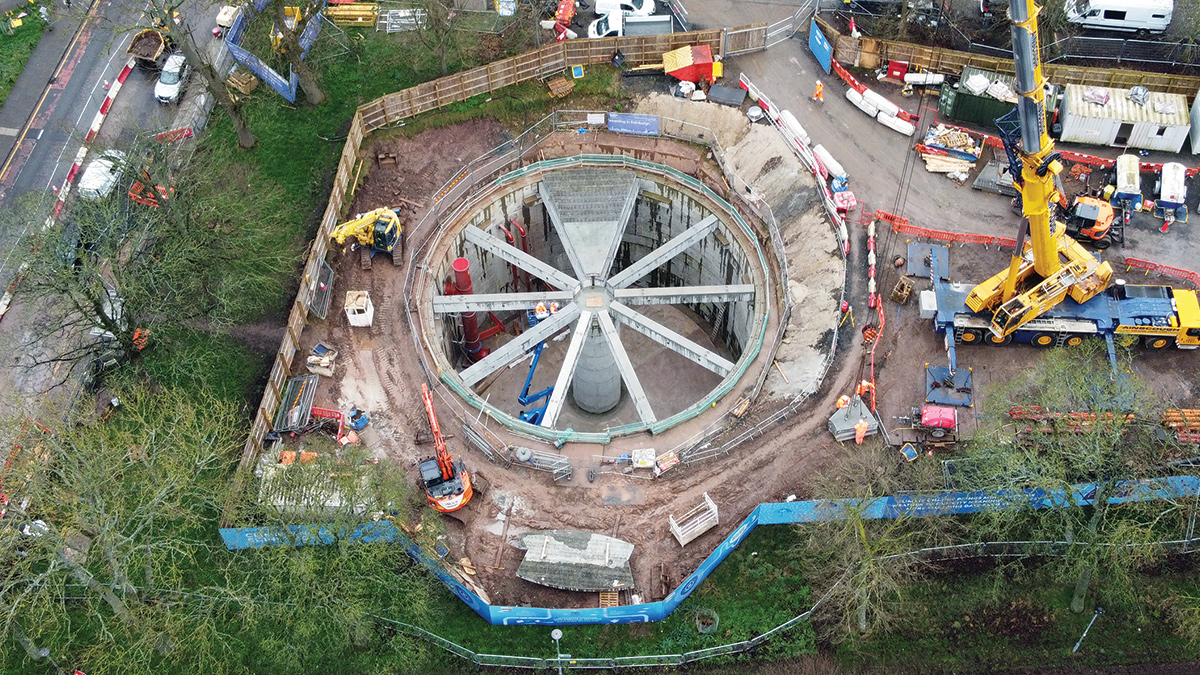
Storm tank roof installation – Courtesy of Paul Milligan & Caledonia Water Alliance
Interface with the public & other utilities
Due to the location of works being adjacent to property and business owners, Caledonia Water Alliance was required to maintain access to these properties at all times. This dictated the construction programme and traffic management set-up. As a result, it has also driven the construction methods of sections of the works; such as the timber heading trenchless construction.
The urban environment of the works resulted in the excavation works being in close vicinity/below other public utility providers’ assets. This has required close liaison with providers, watching briefs, vibration monitoring and change to construction methods.
Local residents have been kept informed throughout all phases of the project as well as regular one on ones with local businesses. A public information event was held in Meadows Park before the work commenced, allowing customers to discuss the upcoming project with professionals from both CWA and Scottish Water.
The dense rock breaking in close proximity to residential tenements proved challenging and expected noise levels were published on the customer notice board on a weekly basis. Extensive pre/post condition surveys were offered to all residents. Site hoarding was specially designed to include information about the project and the local history of Marchmont. Scottish Water campaigns such as ‘Bin the wipes’ were also promoted.
Together with Scottish Water, CWA helped launch a new water ‘top-up-tap’ in Meadows Park to leave a legacy for the park users and reduce the amount of single use plastic bottles. On completion of the project, the area around the tank will be seeded with a wild meadow mix chosen by the Marchmont community.
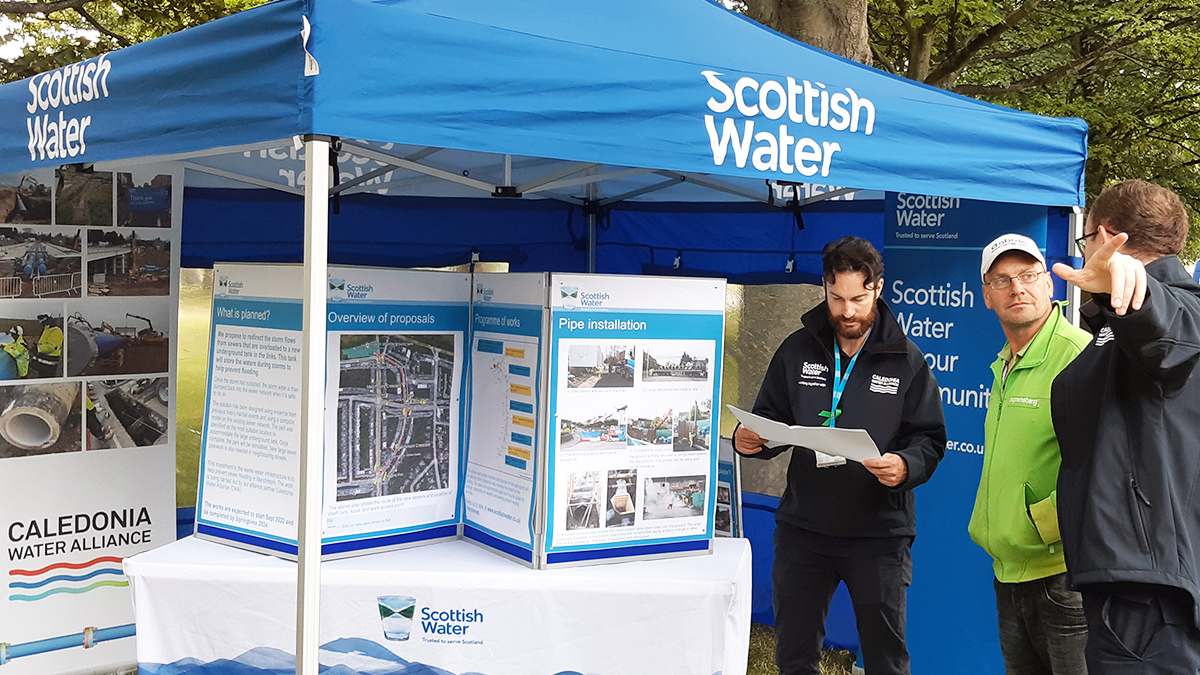
Customer information event – Courtesy of Scottish Water
Conclusion/summary
The next phase (five) of the project commenced on 7 July 2024 to upsize the sewers work on Marchmont Crescent. Phase 5 involves excavating within the road to install larger sewer pipes, and to install new manholes.
Due to the extensive works being carried out, traffic management will be in place to ensure the safety of customers and residents. Throughout the road closures, CWA have ensured that local business will remain open. To further minimise the impact to residents and business, all work is being conducted in short phases.
At the end of the project, CWA will fully reinstate Meadows Park and are planning to team up with the local community to plant wild meadow seeds in the area.
The project is due to be completed by December 2024.







